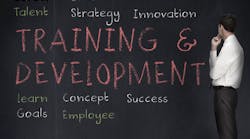Can Training Solve the Skills Gap in Manufacturing?
Often the U.S. manufacturing sector is often praised for having built a thriving American middle class and solidifying the nation as an industrial force. But, in recent years the industry has been seriously challenged to maintain its competitive standing, which was put into sharp effect when Detroit — a manufacturing-focused region — endured the debilitating effects of its residents abandoned the city by the millions, and ultimately filed for bankruptcy. Since the 2007-2009 recession, the manufacturing sector has dealt with multiple impediments to its full recovery, and its has seen sparks of revitalization. Hiring is beginning to pick up and more jobs are available, but there are fewer qualified candidates to fill these roles. Effective training may be the remedy to this Skills Gap issue.
It’s worse than you think — There is no denying that a Skills Gap is plaguing the manufacturing sector, and one of the greatest challenges that manufacturers must address now is to convince a new generation of workers to make the same career choice they made a generation ago (or more.)
The Skills Gap is particularly distressing in industrial engineering, a vital aspect of innovation in manufacturing. Though industrial engineering is one of the fastest growing fields in engineering overall, it has one of the largest populations of nearly retired workers. In fact, 25% of industrial engineers are 55 years old, or older, and soon will be leaving factories and offices for lakeside cabins and book-lined family rooms. There aren’t enough new candidates to replace them.
Manufacturing operations already know the ramifications of this wide Skills Gap; industrial engineering had three times more unique monthly job postings than average monthly hires from 2012 to 2014.
Industrial engineering is far from being the only manufacturing niche affected by this Skills Gap. Studies by the Manufacturing Institute and Deloitte estimate that the U.S. manufacturing sector will have a shortage of 2 million workers, across the board, over the next decade.
Skills become outdated — The Skills Gap is made more acute because the skills that many workers have and list on résumés will remain valid for just a few years, at best. A study conducted by Bridge by Instructure discovered that 75% of college-educated workers believe the knowledge and skills in their field become outdated quickly. Moreover, 90% of them think that changes in their field require them to update their knowledge and learn new professional skills.
The problem of the Skills Gap — heightened by highly perishable skills — underscores the critical need for companies across the manufacturing sector to offer recurring, effective and relevant training to their employees. To be more appealing to the incoming workforce and to bolster their existing one, manufacturing organizations need to provide continuous education that will "upskill" their employees.
Three-Point Strategy
Delivering this education may prove to be challenging within the specific parameters of the manufacturing sector. But, do not be intimidated by the challenge; here are three simple ways to implement effective training.
1. Make training mobile — As a group, Americans check their smartphones 8 billion times a day, a 2015 Deloitte report informs us. On top of that, 72% of the U.S. population owns a smartphone, which is 12% more than the percentage of the eligible American population that votes in the presidential election. Our nation — in fact, our world — is moving to the mobile device at an accelerating pace.
The workforce also looks to these devices for their education, using web-based content as their virtual textbooks. Bridge’s study found that 80% of employees are turning to their mobile devices for continuing education, and learning from Internet sources. To get ahead of this self-education, meet employees where they are: on their smartphones. Create training that is web-based and mobile-optimized so your scattered workforce dispersed across offices, warehouses and factories can access your courses anywhere, anytime.
2. Make it easy to digest — It’s human nature to want “instant gratification and quick fixes.” As soon as content becomes lengthy or difficult to comprehend, we bail. No wonder so many of us will binge on Netflix rather than audit online neuroscience classes in our spare time. Our concentration levels have even regressed in recent years, from 12 seconds in 2000 to eight seconds in 2015, which is shorter than the attention span of a goldfish!
With all these facts in mind, it’s important that manufacturing companies create training that is streamlined and concise, to maximize employee engagement.
3. Teach skills they won’t find elsewhere — As manufacturing fatalities have increased in recent years, it’s imperative that you teach your staff proper safety behaviors and precautions. Perhaps even more important, however — and may give you a leg up on the competition for upcoming talent — is providing education in skills unique to your company’s personnel. Manufacturing companies should leverage the particular skills and experiences from their managers and leadership to offer training lower-level employees will not gain anywhere else. This customized training creates an incentive for employees to remain with the company.
The benefits of training — Cultivating a company culture that emphasizes continual education will reward not only the employees, but the organization as a whole. Effective training will ensure appropriate safety measures are met, but also increase enterprise productivity and retain top performers. Stimulating the ability for employees to gain expertise and share it with colleagues and coworkers will upskill each one of them, and therefore drive overall success. In the process, it will narrow the Skills Gap.
Jeff Weber is the senior vice president of People and Places at Bridge by Instructure — a mobile learning platform for SaaS-based organizational training. He has over two decades of human resources experience, and specializes in enhancing the employee experience for individuals, while supporting an environment of performance, transparency, learning, and growth. Contact Weber at jeffw@instructure.com




